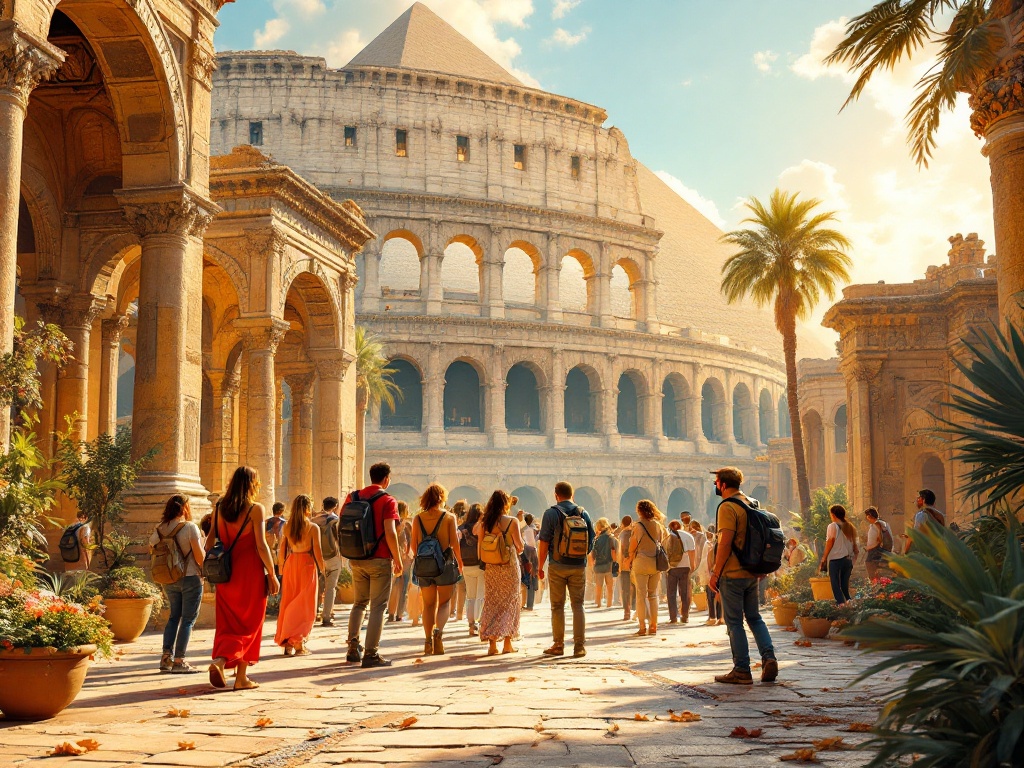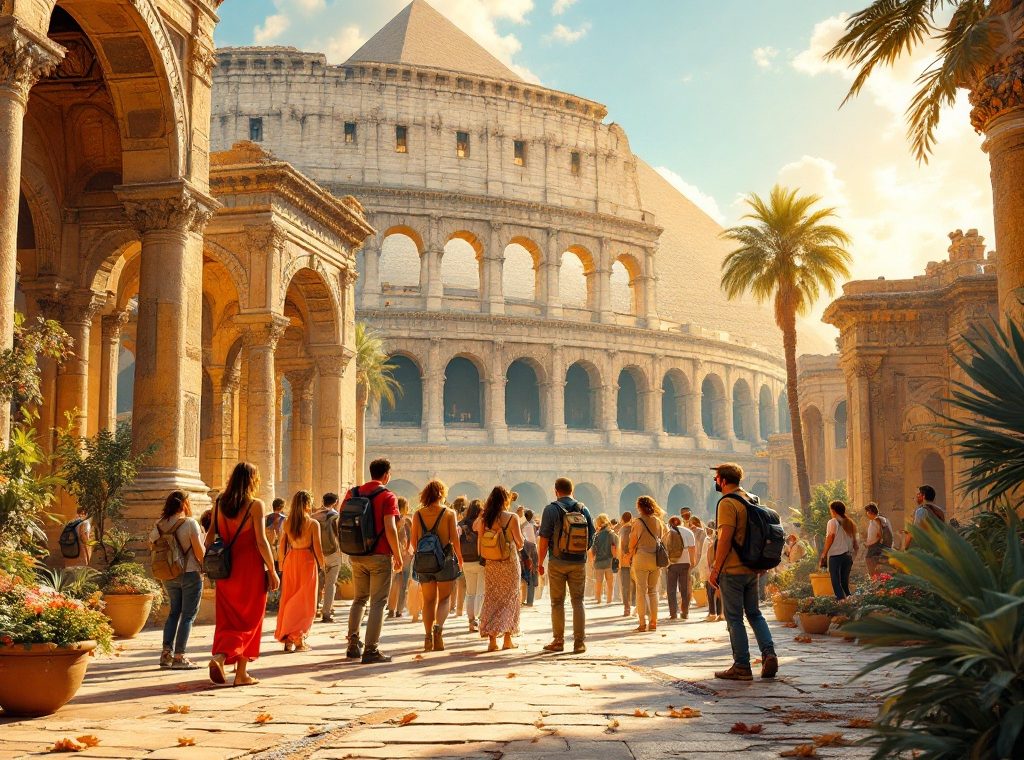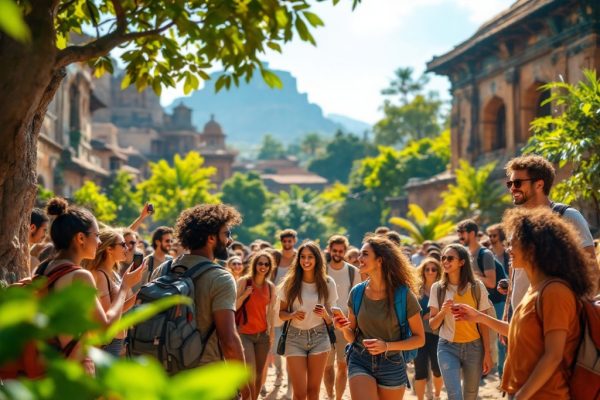Learning History Through Travel
Want to transform history from boring textbooks into a vibrant adventure? Traveling to historical sites immerses you in the past, connecting you to captivating stories and cultures. Explore iconic landmarks like the Colosseum and the Pyramids, walk the Freedom Trail, and discover indigenous traditions. This immersive learning experience fosters empathy and deepens your understanding of global heritage. Start planning your historical journey today!
Important information

- Traveling to historical sites makes history come alive, offering a deeper understanding than textbooks.
- Experiencing local cultures and communities adds authentic stories and perspectives to historical narratives.
- Travel connects history to the present, encouraging critical thinking and fostering empathy.
- Visiting museums, landmarks, and cultural attractions enriches the learning experience and offers valuable context.
- Travel promotes personal growth by deepening cultural understanding and broadening global perspectives.
Benefits of Learning History Through Travel
Traveling offers a powerful way to experience history firsthand. Visiting historical sites, museums, and landmarks brings the past to life, offering a deeper understanding and appreciation. Unlike textbooks, travel immerses you in the historical context of diverse cultures and societies, creating a richer learning experience. This immersive approach makes learning engaging and memorable. Furthermore, travel encourages critical thinking by connecting history to the present. Engaging with local communities provides unique perspectives and authentic stories, breathing life into historical narratives. This fosters empathy, connecting you with the past and enriching your appreciation of global history and heritage.
How Travel Enriches Historical Understanding
Journeying to historical sites breathes life into the past. Exploring landmarks offers valuable context, allowing us to vividly picture historical events. Immersing ourselves in local cultures reveals history’s lasting influence on our world.
By standing in the very spots where history unfolded, we develop a profound appreciation for its complexities. These narratives, often intricate and layered, become clearer through the lens of travel. Travelers gain a richer understanding by engaging directly with the environment, examining artifacts, and interacting with local communities. This immersive experience transforms history from a textbook subject into a tangible reality.
Personal Growth and Transformative Experiences
Travel is a powerful catalyst for self-discovery, offering unique experiences and challenges that foster personal growth. Exploring historical sites deepens your understanding of diverse cultures and provides new global perspectives. This active learning ignites intellectual curiosity and can be mentally invigorating. Reflecting on historical contexts encourages introspection and fuels further personal development.
Key Reasons to Explore History and Culture Through Travel
Traveling deepens our understanding of history and culture. Visiting historical sites firsthand surpasses textbooks, forging a profound connection to the past. Immersing ourselves in different cultures offers insights into local traditions and reveals how history shapes the present. Travel fosters critical thinking and empathy, enriching our understanding of global heritage. Each destination presents a unique piece of humanity’s story. Exploring diverse regions amplifies marginalized voices, creating a more holistic understanding. Engaging with local communities brings history to life through their authentic stories, ultimately enriching our appreciation of culture.
Historical and Cultural Enrichment
Travel transforms history from dusty textbooks into a vibrant reality. Visiting historical sites breathes life into the past, connecting places with captivating stories. Immersing yourself in the local culture adds another dimension, allowing you to interact with communities and discover their unique traditions. By experiencing local customs and perhaps even learning a new language, you gain fresh perspectives and see how the past shapes the present. This deepens your historical understanding in a way no book can. Travel offers a powerful, multi-faceted approach to learning, bridging the gap between knowledge and experience.
Expanding Perspectives as Global Citizens
Travel transforms you into a global citizen, providing firsthand cultural experiences and fresh perspectives. Encountering diverse lifestyles challenges preconceived notions and fosters empathy, forging connections and highlighting our shared humanity. Travelers gain a deeper understanding of global issues, promoting responsibility and intercultural dialogue, ultimately broadening their horizons.
Planning Your Historical Journey for Maximum Impact
Enhance your historical journey by mapping key sites, boosting its educational value. Pre-trip research provides context and deepens your understanding. For a richer experience, explore museums, landmarks, and cultural attractions.
Mapping Travel Patterns for Historical Significance
History-based travel connects our present with the past, offering valuable insights into significant events and their lasting impact. Exploring destinations through a historical lens transforms travel into a richer, more meaningful experience. It fosters a deeper appreciation for the past and the forces that have shaped our world.
Journey Through Time
Tracing the Silk Road reveals intricate patterns of commerce, cultural exchange, and the spread of various faiths. This historical route offers a glimpse into a world of interconnected civilizations and the enduring legacies of trade and cultural diffusion.
Age of Exploration
Following the voyages of explorers like Columbus and Magellan illuminates the Age of Exploration. These journeys, while significant, also expose the complex consequences of this era, including the impact on indigenous populations and the reshaping of global power dynamics.
Westward Expansion
The Oregon Trail embodies both the arduous challenges of westward migration and the promise of new beginnings for settlers. This historical route reflects the resilience of those seeking new opportunities and the transformative impact of westward expansion on the American landscape.
Connecting with the Past
History-based travel allows us to connect with the past in a tangible way. By exploring historical sites, we gain a deeper understanding of the events and people that have shaped our world. It enriches our travel experiences and fosters a greater appreciation for the complexities of history.
Incorporating Cultural Exchange and Global Citizenship
Immerse yourself in cultural exchanges, experiencing local traditions and festivals. A homestay or volunteer opportunity offers deeper immersion, fostering global citizenship and promoting understanding and empathy. This encourages respect for diverse perspectives. Active participation transforms travel into a journey of personal growth, contributing to a more connected world.
Top Historical Destinations for Educational Travel
World Heritage Sites offer fascinating glimpses into different cultures. From the Acropolis of Athens to Rome’s Historic Centre and India’s Taj Mahal, these architectural wonders showcase the diversity of human civilization.
Iconic landmarks also have stories to tell. The Eiffel Tower, Statue of Liberty, and Great Wall of China each represent pivotal moments in history, demonstrating remarkable engineering while connecting us to the past.
Indigenous cultures provide unique perspectives on our shared heritage. Australia’s Uluru-Kata Tjuta National Park and the US’s Mesa Verde National Park reveal compelling details about human history and cultural traditions.
Exploring UNESCO World Heritage Sites
UNESCO World Heritage Sites offer captivating glimpses into the past. These internationally recognized landmarks, chosen for their outstanding universal value, represent humanity’s most remarkable accomplishments. From natural wonders like the Grand Canyon to cultural icons such as the Taj Mahal, these sites provide enriching and inspiring educational journeys. They offer unique opportunities to witness history, architecture, and nature’s artistry firsthand. Exploring these sites fosters a deeper appreciation for human civilization and our planet’s diverse heritage.
Visiting Iconic Historical Landmarks
Embark on a journey to historical landmarks and uncover captivating glimpses into the past. Explore scientific breakthroughs at places like London’s Royal Greenwich Observatory, the Einstein Tower in Potsdam, and Cambridge’s Cavendish Laboratory.
Delve into rich cultural heritage at sites such as Fort Santiago, Intramuros, and San Agustin Church in Manila. Discover ancient wonders like the Colosseum, the Pyramids of Giza, the Great Wall of China, and Machu Picchu, each offering unique insights into bygone civilizations.
Scientific museums like the Galileo Museum in Florence, London’s Science Museum, and Munich’s Deutsches Museum house vital artifacts and present engaging exhibits. These institutions connect us to history and deepen our understanding of how past events have shaped our present world.
Discovering Indigenous Cultures and Traditions
Immersing oneself in indigenous cultures offers invaluable insights into their unique histories and traditions, as well as the contemporary challenges they face. This firsthand experience fosters cross-cultural understanding and a deeper appreciation for diverse worldviews.
Engaging Activities for Learning History While Traveling
Explore a city’s captivating history with a local guide. They’ll offer unique perspectives on past events and architectural wonders, sharing fascinating stories and hidden gems. Trace Boston’s revolutionary past along the Freedom Trail, discovering key sites from this pivotal era.Museums breathe life into history. Explore artifacts and exhibits that provide rich context and details about specific periods, like London’s British Museum with its vast collection spanning human history. Architectural explorations offer another avenue for discovery. Examine historic buildings like the Notre Dame Cathedral, a stunning example of Gothic architecture.
Step back in time with immersive experiences that connect you to ancient civilizations.
Explore the preserved Roman ruins of Pompeii, witnessing tangible evidence of past cultures.
Gain insights into how people lived.
Walking Tours and Their Historical Insights
Embark on a captivating walking tour to uncover a city’s rich history. Expert guides share fascinating stories and anecdotes, bringing the past to life. These enriching experiences reveal hidden gems and offer unique perspectives you won’t find in any guidebook, providing a deeper understanding of the area. While some tours cover several miles, the firsthand stories and insights make every step worthwhile.
Museums and Architectural Explorations
Museums house captivating artifacts, offering glimpses into the past. Architectural explorations are equally revealing, showcasing a society’s values, technologies, and artistic trends. Architecture reflects the passage of time, and together with museums, provides a tangible link to history and culture, connecting us to our shared heritage.
Immersive Experiences at Archaeological Sites
Immersive experiences at archaeological sites bridge the gap between us and the past. Hands-on activities, such as excavations and interactive exhibits, breathe life into ancient civilizations. Exploring reconstructed dwellings offers a glimpse into their world, deepening our understanding of their lasting impact. These encounters transform history from abstract concepts into tangible realities.
Famous Historical Sites and Their Educational Value
Rome’s Colosseum offers a glimpse into the lives of its ancient inhabitants, from their thirst for entertainment to their social hierarchy and advanced engineering. Within its walls, gladiators clashed, executions were carried out, and even wild animal hunts thrilled the crowds. The very structure itself stands as a monument to Roman ingenuity.
Remnants of ancient civilizations provide captivating insights into their cultures. Egypt’s Pyramids of Giza and Greece’s Parthenon are prime examples. These structures illuminate ancient cultures, religions, and architectural prowess. The Pyramids, specifically, reveal Egyptian burial rituals and beliefs about the afterlife, while the Parthenon embodies Greek architecture and mythology.
Visiting battlefields and memorials like Gettysburg in the USA and Auschwitz-Birkenau in Poland offers profound lessons. Gettysburg provides a window into the American Civil War. Auschwitz-Birkenau bears witness to the horrors of the Holocaust. These sites prompt reflection on conflict, loss, and the crucial importance of human rights, serving as somber reminders of the past.
The Colosseum: Insights into Roman Entertainment
The Colosseum hosted a variety of spectacular events, including thrilling gladiatorial contests, animal hunts, and public executions. These spectacles reflected Roman values by highlighting social hierarchies and political motivations.
The Colosseum’s ingenious design facilitated efficient crowd management through strategically placed entrances, exits, and seating arrangements. This ensured optimal viewing for every social class. The Colosseum also provides insights into Roman engineering and their remarkable construction methods.
In-depth Exploration of Ancient Civilizations
Ancient civilizations provide invaluable insights into the human experience. The Egyptians, known for their hieroglyphics and awe-inspiring pyramids, left a remarkable legacy. The Greeks laid the foundations of democracy and philosophy that we still benefit from today. Studying these societies illuminates the path of human progress, revealing the evolution of language, the origins of government, and the development of cultural norms. Their advancements in mathematics, astronomy, and medicine continue to influence modern practices. Exploring these ancient cultures fosters a deeper appreciation for human ingenuity and connects us to our shared past. For instance, consider the following:
- Egyptian hieroglyphics: this complex writing system preserved their history and beliefs, offering a window into their world.
- Greek democracy: the innovative political system of ancient Greece significantly influenced the development of modern governments.
- Advancements in mathematics: both the Egyptians and Greeks made significant mathematical discoveries that are still relevant today.
Visiting Battlefields and Memorials
Battlefields and memorials offer powerful lessons, revealing the impact of past conflicts. Gettysburg, for instance, illuminates the American Civil War’s significance. Beyond Gettysburg, places like Fort Santiago in Manila offer further insights, connecting us to the Philippines’ struggle under Spanish rule. Visiting these sites fosters a deeper understanding of history and its lasting consequences.










